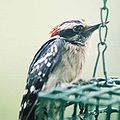- Hairy Woodpecker
-
Hairy Woodpecker 
Male of an eastern race, probably septentrionalis Conservation status Scientific classification Kingdom: Animalia Phylum: Chordata Class: Aves Order: Piciformes Family: Picidae Genus: Picoides Species: P. villosus Binomial name Picoides villosus
(Linnaeus, 1766)Synonyms Dryobates villosus
The Hairy Woodpecker (Picoides villosus) is a medium-sized woodpecker, averaging approximately 250 mm (9.75 inches) in length with a 380 mm (15 inch) wingspan.[1] With an estimated population in 2003 of over nine million individuals, the Hairy Woodpecker is listed by the IUCN as a species of least concern in North America.[2]
Contents
Range
The Hairy Woodpecker inhabits mature deciduous forests[1][3] in the Bahamas, Canada, Costa Rica, El Salvador, Guatemala, Honduras, Mexico, Nicaragua, Panama, Puerto Rico, Saint Pierre and Miquelon, Turks and Caicos Islands, and the United States.[2] Mating pairs will excavate a hole in a tree, where they will tend to, on average, four white eggs.[3]
Description
 Female of the Great Basin race, orius, which has less white on the wings than eastern races and has cream-colored underparts
Female of the Great Basin race, orius, which has less white on the wings than eastern races and has cream-colored underparts
Adults are mainly black on the upper parts and wings, with a white or pale back and white spotting on the wings; the throat and belly vary from white to sooty brown, depending on subspecies. There is a white bar above and one below the eye. They have a black tail with white outer feathers. Adult males have a red patch or two side-by-side patches on the back of the head; juvenile males have red or rarely orange-red on the crown.[4]
The Hairy Woodpecker measures from 18–26 cm (7.1–10 in) in length, 33–43 cm (13–17 in) in wingspan and 40–95 g (1.4–3.4 oz) in weight.[5][6] It is virtually identical in plumage to the much smaller Downy Woodpecker. The Downy has a shorter bill relative to the size of its head which is, other than size and voice, the best way to distinguish them in the field. These two species are not closely related, however, and are likely to be separated in different genera.[7][8] The best way to tell the two species apart other than the size is the lack of spots on its white tail feathers (which the Downy has). Their outward similarity is a spectacular example of convergent evolution. As to why this convergence has evolved, only tentative hypotheses have been advanced; in any case due to the considerable size difference, ecological competition between the two species is rather slight.
These birds are mostly permanent residents. Birds in the extreme north may migrate further south; birds in mountainous areas may move to lower elevations.
These birds forage on trees, often turning over bark or excavating to uncover insects. They mainly eat insects, also fruits, berries and nuts, sometimes tree sap. They are also known to peck at wooden window frames and wood sided homes that may house bugs.
See also
- Downy woodpecker - A smaller but very similar-looking species.
References
- ^ a b Sibley, David Allen (2003). The Sibley Field Guide to Birds of Eastern North America. Alfred A. Knopf, Inc. p. 249. ISBN 0-679-45120-X.
- ^ a b "Picoides villosus". International Union for Conservation of Nature and Natural Resources. http://www.iucnredlist.org/apps/redlist/details/141717/0/full. Retrieved 2009-03-24.
- ^ a b Bull, John; Farrand, Jr., John (August 1994) [1977]. National Audubon Society Field Guide to North American Birds:Eastern region (2nd ed.). Chanticleer Press. p. 573. ISBN 0-679-42852-6.
- ^ Jackson, Jerome A., Henri R. Ouellet, & Bette J. Jackson (2002): Hairy Woodpecker (Picoides villosus), The Birds of North America Online (A. Poole, Ed.). Ithaca: Cornell Lab of Ornithology; Retrieved from the Birds of North America Online 2009-3-20 doi:10.2173/bna.702 (registration required)
- ^ [1] (2011).
- ^ [2] (2011).
- ^ Weibel, Amy C. & Moore, William S. (2005): Plumage convergence in Picoides woodpeckers based on a molecular phylogeny, with emphasis on convergence in downy and hairy woodpeckers. Condor 107(4): 797–809. doi:10.1650/7858.1 (HTML abstract)
- ^ Moore, William S.; Weibel, Amy C. & Agius, Andrea (2006): Mitochondrial DNA phylogeny of the woodpecker genus Veniliornis (Picidae, Picinae) and related genera implies convergent evolution of plumage patterns. Biol. J. Linn. Soc. 87: 611–624. PDF fulltext
External links
- Hairy Woodpecker - Picoides villosus - USGS Patuxent Bird Identification InfoCenter
- Hairy Woodpecker Species Account - Cornell Lab of Ornithology
- Hairy Woodpecker Information and Photos - South Dakota Birds and Birding
- Hairy Woodpecker, Bird sound
Photo gallery
Categories:- IUCN Red List least concern species
- Picoides
- Woodpeckers
- Birds of North America
- Birds of Canada
Wikimedia Foundation. 2010.





